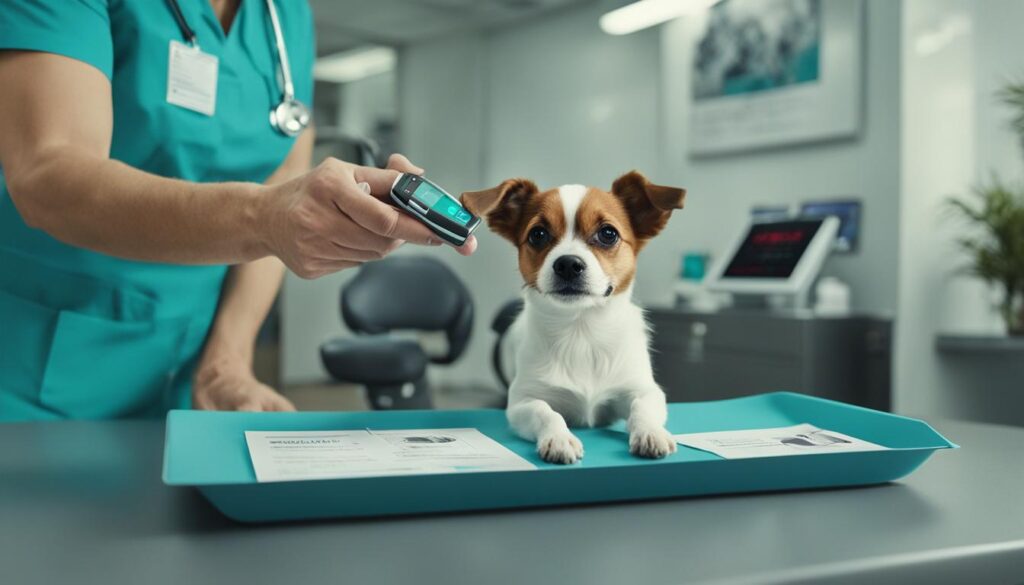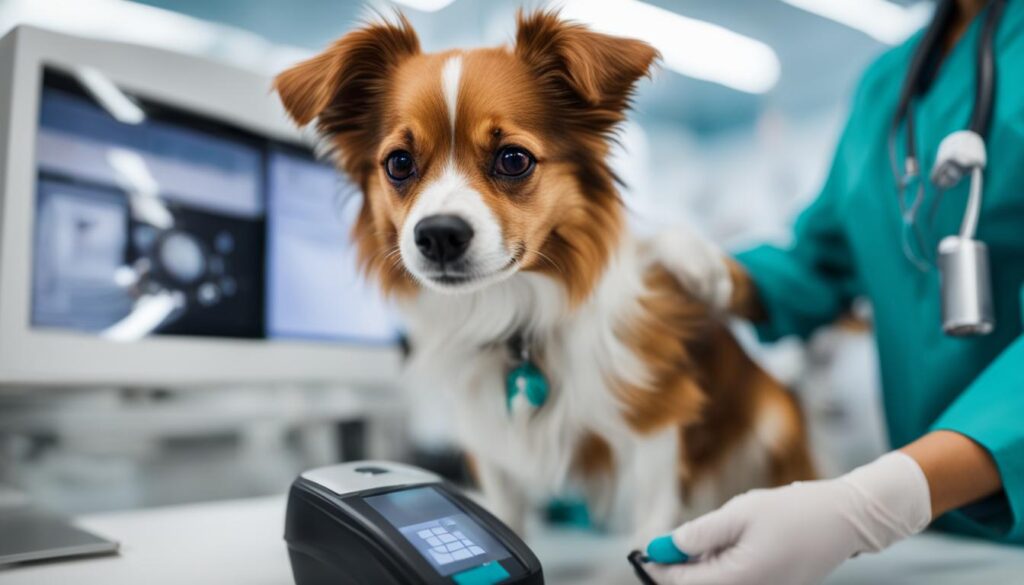Giving your dog a safe and secure identification method is essential for their well-being. Microchipping is a popular and effective way to ensure that your furry friend can be identified if they ever get lost. But how much does it cost to microchip a dog? In this article, I’ll provide insights and tips on the cost of microchipping, factors that affect the cost, and why it’s important to consider this investment for the safety of your beloved pet.
Factors That Affect the Cost of Microchipping

The cost of microchipping your dog can vary depending on several factors. Here are some key factors that can influence the overall cost:
- Location: The cost of microchipping can vary depending on where you are located. Larger metropolitan areas tend to have higher prices compared to rural areas.
- Type of Facility: The location where you choose to get your dog microchipped can also impact the cost. Veterinary clinics typically charge more for microchipping services compared to non-profit animal clinics.
- Registration Responsibility: Who is responsible for registering the microchip can affect the cost. If you register the chip online yourself, it is usually cheaper compared to having the veterinary clinic handle the registration process.
Considering these factors can help you understand and plan for the cost of microchipping your dog.
What’s Included in the Cost of Microchipping a Dog?

The cost of microchipping a dog typically includes the microchip itself, the procedure to implant the chip under the dog’s skin, and the registration of the chip. The registration connects the dog’s identification number to an online registry with your contact information. However, it’s important to confirm with the clinic whether the cost includes the registration or if it is an additional fee that the owner must handle.
| Items Included in the Cost of Microchipping a Dog |
|---|
| Microchip |
| Procedure to implant the chip |
| Registration of the chip |
The microchip itself is the small implant that contains a unique identification number. The procedure involves a veterinarian or trained professional inserting the microchip under the dog’s skin, usually between the shoulder blades. Finally, the registration of the chip ensures that your contact information is linked to the dog’s identification number in a database, making it easier to locate you if your dog is lost or found.
It’s always recommended to confirm the price and what’s included with the clinic or animal service provider before proceeding with the microchipping process. This way, you can ensure that you have a clear understanding of the total cost and any additional fees or services that may be necessary.
Microchipping is a reliable method of identifying your dog if they get lost.
Is Microchipping Required for Dogs?

While microchipping is not required in all states or areas, some places have implemented mandatory microchipping laws. For example, Hawaii became the first state in the United States to require pet microchipping. Additionally, certain cities and counties have their own regulations. Even if microchipping is not mandatory in your area, it is highly recommended as it increases the chances of a lost dog being returned to its owner.
Key Points:
- Microchipping is not required in all states or areas
- Hawaii was the first state in the United States to require pet microchipping
- Certain cities and counties may have their own microchipping regulations
- Microchipping is highly recommended even if not mandatory, as it increases the chances of reuniting lost dogs with their owners
What Should I Know About How Microchips Work?

Microchips are a vital component of the dog microchipping process. These tiny implants, about the size of a grain of rice, are placed under a dog’s skin, typically between the shoulder blades. The insertion is a quick and relatively painless procedure, often done during a regular veterinarian visit.
Once implanted, microchips serve as a permanent form of identification for dogs. Each microchip contains a unique identification number, which is associated with the dog’s owner in a secure database. When a scanner is passed over the microchip, the chip emits a radio frequency that transmits the identification number to the scanner.
The scanner then uses this identification number to look up the owner’s contact information in the database. It is crucial for pet owners to ensure that their contact information is up-to-date and registered with the microchip company to maximize the chances of being reunited with their lost dog.
It’s important to note that microchips do not have tracking capabilities like GPS devices. They rely on a third party, such as a veterinarian or shelter, to scan the dog and access the information in the database. Microchips should not be solely relied upon as a locator beacon for a lost dog, but rather as a means of identification to facilitate a reunion with the owner.
Are There Alternatives to Getting My Dog Microchipped?
If you are opposed to microchipping or if your dog cannot be microchipped for medical reasons, there are alternatives available. One option is using GPS-enabled collars or tags, which can help locate your dog’s precise location if they go missing. However, it’s important to consider the cost, as GPS devices tend to be more expensive than microchips or traditional collars and tags.
While microchipping provides reliable and permanent identification, GPS-enabled collars or tags offer real-time tracking capabilities. These devices use satellite technology to pinpoint your dog’s location, allowing you to find them quickly. They are particularly useful for active dogs or those with a history of wandering.
GPS trackers for dogs typically require cell service and have a battery that needs to be recharged regularly. Additionally, some devices may have subscription fees associated with accessing the tracking service. It’s important to research and compare different brands and models to find the most suitable and affordable option for your needs.
Keep in mind that GPS-enabled collars or tags may not provide the same level of identification as microchips. They rely on the collar or tag remaining attached to the dog and functioning properly. In contrast, microchips are a permanent form of identification that cannot be lost or removed.
Ultimately, the choice between microchipping and using GPS-enabled collars or tags depends on your preferences, budget, and your dog’s specific needs. Discussing your options with a veterinarian can help you make an informed decision and ensure your dog’s safety.
| Microchipping | GPS-Enabled Collars/Tags |
|---|---|
| Permanent form of identification | Real-time tracking capabilities |
| Relies on a microchip scanner to retrieve information | Requires cell service for tracking |
| Cannot be lost or removed | Collar or tag can be lost or damaged |
| Lower upfront cost | Higher upfront cost |
| Registration may be included in the microchipping cost | Subscription fees may apply for tracking service |
Does Pet Insurance Cover Microchipping for My Dog?

When it comes to the cost of microchipping your dog, the coverage provided by pet insurance policies can vary. It’s important to check with your insurance provider to determine if microchipping is a covered expense. While some policies may include microchipping as part of their coverage, others may consider it an optional or additional service.
If your pet insurance policy doesn’t cover the cost of microchipping, there are alternative options available. Local animal shelters or non-profit clinics often offer low-cost or even free microchipping services, making it more affordable for pet owners. Additionally, veterinary clinics may provide flexible payment plans to help make the procedure cost-effective.
Ensuring that your dog is microchipped is a responsible choice that can greatly increase the chances of their safe return if they go missing. While the cost may vary, exploring different avenues for affordable dog microchipping can help provide this vital form of identification for your furry friend.
| Pros | Cons |
|---|---|
| Some pet insurance policies may cover the cost of microchipping | Not all pet insurance policies include microchipping as a covered expense |
| Local animal shelters and non-profit clinics may offer low-cost or free microchipping services | The availability of affordable microchipping services may vary depending on location |
| Veterinary clinics may provide flexible payment plans for microchipping | Microchipping cost may still be a financial burden for some pet owners |
Why Owners Should Microchip Their Dogs

Microchipping provides a reliable and permanent form of identification for dogs. It significantly increases the chances of a lost dog being reunited with their owner. Microchipping is a simple and relatively painless procedure that can be done during a regular vet visit. The cost of microchipping is a small price to pay for the peace of mind knowing that your dog has an extra layer of protection against getting lost.
Microchipping your dog is a responsible decision that can save you from the heartache of losing your beloved pet. The process involves implanting a tiny microchip, about the size of a grain of rice, under your dog’s skin. This chip contains a unique identification number that can be scanned by animal shelters, veterinary clinics, and other authorized organizations.
When a lost or stray dog is found, it is usually taken to a shelter or veterinarian to check for a microchip. By having your dog microchipped, you greatly increase the chances of being reunited with them in case they go missing. Without proper identification, it can be challenging to locate the owner of a lost dog, especially if the dog doesn’t have any visible tags or collars.
The cost of microchipping is relatively affordable compared to the potential costs and emotional distress of losing your dog. The peace of mind that comes with knowing that your dog has a permanent form of identification is invaluable. By microchipping your dog, you are taking a proactive step in ensuring their safety and well-being.
Microchipping is a simple and safe procedure that can be done by a veterinarian. During the procedure, the microchip is inserted under the dog’s skin, usually between the shoulder blades. It can be done during a regular vet visit or as part of other procedures, such as spaying or neutering.
Microchipping is a win-win situation for both owners and pets. It provides an additional layer of protection for your dog and increases the chances of a happy reunion if they get lost. The cost of microchipping a dog is a small investment considering the potential benefits it offers.
Benefits of Microchipping:
- Permanent identification for your dog
- Increased chances of finding your lost dog
- Quick and easy registration process
- Peace of mind knowing your dog has an extra layer of protection
- Requirements in certain areas or for specific activities (e.g., travel regulations)
Microchipping your dog is a responsible choice that can make a significant difference in the event that your dog goes missing. It provides a way for your dog to be properly identified, increasing the chances of their safe return. The affordable cost of microchipping is well worth the potential peace of mind and protection it provides. Don’t wait until it’s too late, take the necessary steps to ensure the safety and well-being of your furry friend by microchipping them today.
| Advantages | Disadvantages |
|---|---|
| Reliable and permanent identification | May require additional fees for registration |
| Increased chances of reunion if lost | No tracking capabilities like GPS |
| Quick and easy registration process | Not a substitute for other forms of identification |
How Do Pet Microchips Work?
Pet microchips are tiny transponders that are implanted under a pet’s skin. These chips contain a unique identification number that is linked to the owner’s contact information in a database. When a scanner is passed over the chip, it reads the ID number, allowing veterinarians or shelters to contact the owner. It is important for pet owners to register their contact information with the microchip company to ensure accurate and up-to-date records.
| Process | Explanation |
|---|---|
| Implantation | The microchip is injected under the pet’s skin, typically between the shoulder blades. This procedure is similar to getting a vaccine shot and is quick and relatively painless. |
| Scanning | When a scanner passes over the microchip, it emits a radio frequency that activates the chip. The scanner then displays the unique ID number linked to the pet’s contact information. |
| Contacting the Owner | Veterinarians or animal shelters use the ID number to access the microchip company’s database. They can then retrieve the owner’s contact details, such as name, address, and phone number, to initiate a reunion. |
Microchips provide a reliable and permanent method of identification for pets. They are an effective way to increase the chances of reunion if a pet gets lost or separated from its owner. It is crucial to ensure that the microchip is registered with accurate and up-to-date information to maximize its effectiveness.
Wrapping Up
Microchipping your dog is an essential step in ensuring their safety and increasing the likelihood of reuniting with them if they ever get lost. While the cost of microchipping can vary depending on factors such as the type of microchip used and the location where the procedure is performed, this investment is well worth the peace of mind it provides. By consulting with a trusted veterinarian, you can determine the best options for microchipping your dog and receive expert guidance on the process.
It is crucial to remember that microchipping encompasses more than just the initial procedure. Keeping your contact information up to date in the microchip registry is equally important. By regularly updating your details, you maximize the chances of a quick and successful reunion in the event your dog goes missing.
If microchipping is not a suitable option for your dog, consider alternative solutions like GPS-enabled collars or tags. These devices can help track your dog’s precise location if they wander off. However, it’s essential to take the cost into account, as GPS devices are usually more expensive than microchipping.
In conclusion, microchipping is a responsible and effective way to protect your furry friend. It provides invaluable peace of mind, knowing that you have taken every precaution to ensure their safety. Consult with your veterinarian and explore the options available to you, so you can make an informed decision that best suits your dog’s needs.
FAQ
How much does it cost to microchip a dog?
Microchipping your dog typically costs around $50. The exact cost can vary depending on factors such as the type of microchip used and the location where the procedure is performed.
What factors can affect the cost of microchipping a dog?
The cost of microchipping can be influenced by factors such as the location where you get your dog microchipped and who is responsible for registering the microchip.
What is included in the cost of microchipping a dog?
The cost of microchipping typically includes the microchip itself, the procedure to implant the chip, and the registration of the chip. However, it’s important to confirm with the clinic what is specifically included in the cost.
Is microchipping required for dogs?
Microchipping is not required in all states or areas, but some places have implemented mandatory microchipping laws. It is highly recommended for all pet owners as it increases the chances of a lost dog being returned.
How do microchips work?
Microchips are tiny implants placed under a dog’s skin. When scanned, they emit a radio frequency that transmits the dog’s identification number. This number is then used to look up the owner’s contact information in a database.
Are there alternatives to microchipping for dogs?
If you are opposed to microchipping or if your dog cannot be microchipped for medical reasons, alternatives such as GPS-enabled collars or tags are available. These devices can help locate your dog’s precise location if they go missing.
Does pet insurance cover the cost of microchipping?
Whether pet insurance covers the cost of microchipping depends on the specific policy coverage. It’s recommended to check with your insurance provider to determine if microchipping is a covered expense.
Why should owners microchip their dogs?
Microchipping provides a reliable and permanent form of identification for dogs, significantly increasing the chances of a lost dog being reunited with their owner.
How do pet microchips work?
Pet microchips are tiny transponders that are implanted under a pet’s skin. These chips contain a unique identification number that is linked to the owner’s contact information in a database.
Can you summarize the cost and benefits of microchipping a dog?
Microchipping typically costs around $50 and offers a reliable form of identification for dogs. It increases the chances of reunification if a dog gets lost and is not mandatory in all areas.






